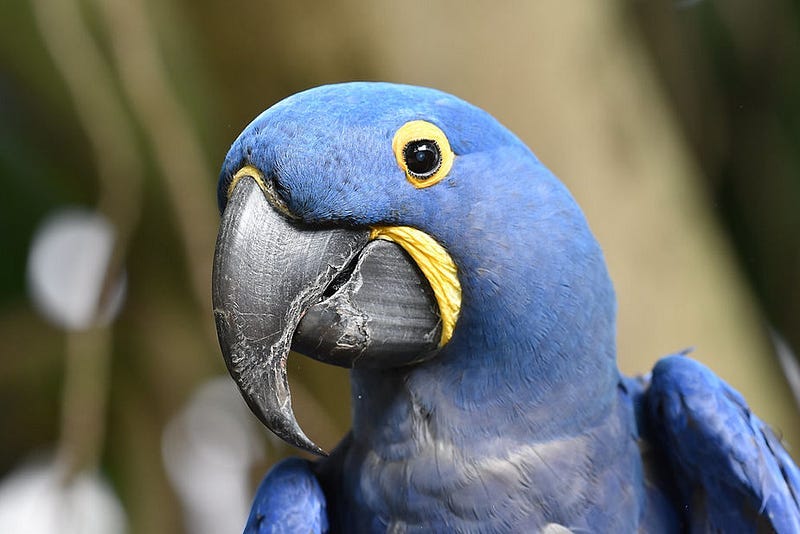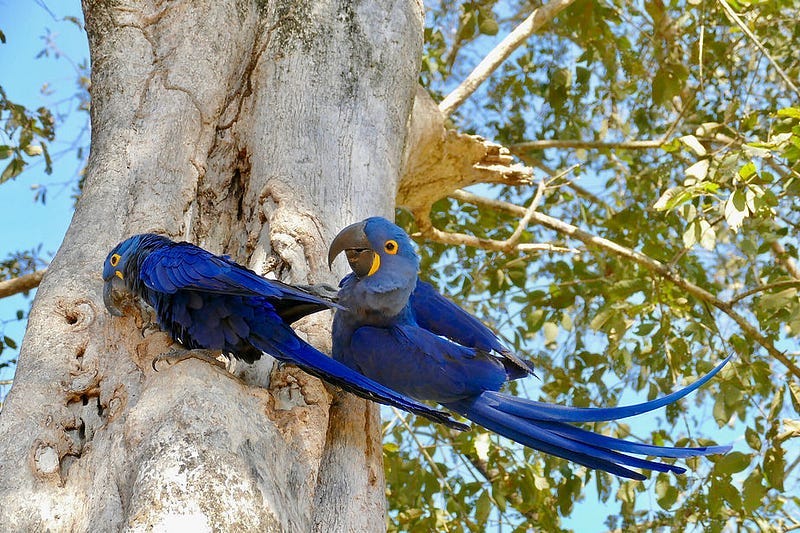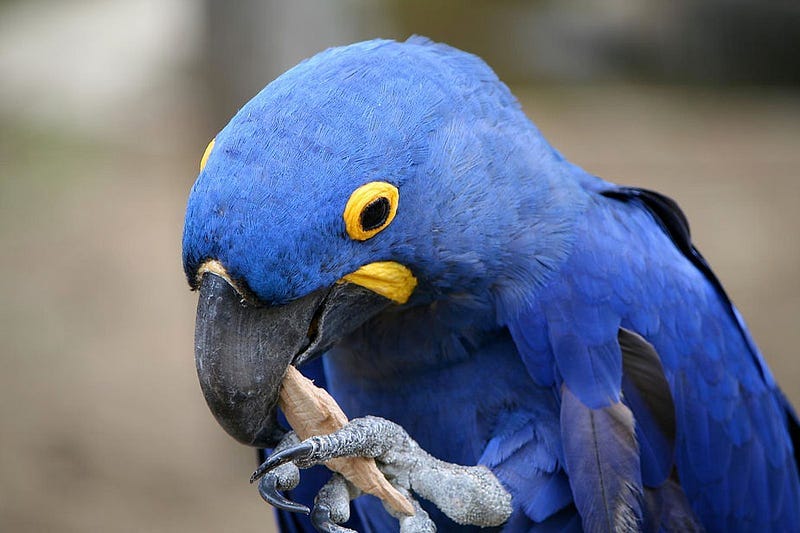Five Brilliant Facts About Hyacinth Macaws
The hyacinth macaw is the largest flying parrot and uses tools to crack hard nuts.
At the time of this writing, September’s dazzling azure skies were as joy-inspiring as they were heavy: Fall was basically here, North America’s migratory birds were already southbound, and winter’s short, cold days were getting ever closer. However, we figured we’d focus on the current moment and celebrate the season by examining one of the bluest of the blue birds, the hyacinth macaw. Ready your wonder helmets. We’re diving in.
Hyacinth Macaw Is the Largest Flying Parrot Species
Coming in at 3.25 feet long from the tip of its tail to the top of its skull, the hyacinth macaw is the largest parrot species on earth. It weighs a whopping 3.75 pounds (which is likely 0.75 pounds more than your weekly bag of grocery store apples, for easy comparison).
Although it’s the longest parrot in the world, that weight is still outdone by another parrot. New Zealand’s flightless sweetheart, the kākāpō, wins the heaviest parrot award. Males of that species can weigh up to about 8.8 pounds!

Hyacinth Macaws Like Hard Nuts
Heh heh. In all grownup seriousness, hyacinth macaw’s bills are built to crack some of the hardest nuts out there. Preferred morsels include coconuts, brazil nuts, macadamia nuts, and the nuts of acuri and bocaiuva palms.
Besides hard nuts (heh), hyacinth macaws also enjoy fruits. Their tongues, which are black with yellow racing stripes to match their eye-rings and the mustachey area beside their bills, contain a hard bone that allows them to poke into fruit with the greatest of ease.
One more thing about acuri nuts: Although hyacinth macaws are hard nut specialists (okay, we’re done acting like juveniles), the birds can only enjoy these specific palm nuts after they’ve passed through a cow’s digestive tract.
Hyacinth Macaws Use Tools
Speaking of hard nuts, hyacinth macaws, both in the wild and captivity, have been observed using tools to assist those strong bills in breaking open their favorite snacks. The bird has two MyGyver-style tricks, both incorporating everyday objects (for parrots in the jungle, anyway). First, a hyacinth macaw may chew off a piece of leaf, then wrap it around a nut to hold it still while the bird makes its way through the nut’s hard exterior. Alternatively, the hyacinth macaw can use sticks or other pieces of wood to wedge the nut in place while it works.

Toco Toucans Are Major Predators, But It’s Complicated
It’s always a bummer to learn that something eats your bird friends. Especially when it’s other birds. In the case of the hyacinth macaw, toco toucans are the perpetrators. Nearly one-quarter of all hyacinth macaw eggs are destroyed by predators, and of those, toco toucans are eating half. Swallowing them whole, in fact, as well as occasionally consuming hatched nestlings. Possums, coatis, and jays are the other nest predators.
What complicates the toco toucans’ predation is that hyacinth macaws rely on these giant-billed birds to thrive. The parrot’s population in Brazil’s Pantanal region nest almost (but not quite) exclusively in manduvi trees, which are increasingly hard to find and take 60 years to mature. Because they’re big trees, they can have big holes in them, and the famously big hyacinth macaws need access to such a large cavity (which these birds don’t carve out themselves) that can accommodate them as they raise their broods. Toco toucans come into play because they are the largest disperser of manduvi tree seeds. According to the nonprofit Mongabay, when they’re not gobbling up hyacinth macaw eggs, toco toucans are collecting and eating 86.3 percent of manduvi seeds, flying far away from other toucans’ territories, and ultimately depositing the seeds. Thereby growing more manduvi trees over time, which the hyacinth macaws need to successfully establish a nest, which toco toucans might eventually rob. And on it goes in a mildly depressing symbiotic relationship.
Hyacinth Macaws Are Vulnerable, But Their Ranges Are Spreading
Hyacinth macaws living in the wild are up against several threats. Besides nest predators, they are threatened by habitat loss through farming, cattle ranching, poaching for their brilliant features, and the exotic pet industry. On top of that, they are typically found only in three isolated regions: Brazil’s Pantanal plus adjacent northeastern Paraguay and eastern Bolivia, the tropical savanna or cerrado region of interior Brazil, and the country’s open riparian regions in the Amazon Basin. Hard-to-traverse terrain has impeded accurate bird counts in the past, but increased sightings in new municipalities in recent years indicate that the species may slowly be recovering. Concentrated conservation efforts focusing on providing nest boxes, protecting the trees vital to the parrots’ survival, and cracking down on the illegal bird trade play a large part in this comeback, per BirdLife International, and they need to continue to ensure the species’ survival in the wild.
……Hard nuts.




